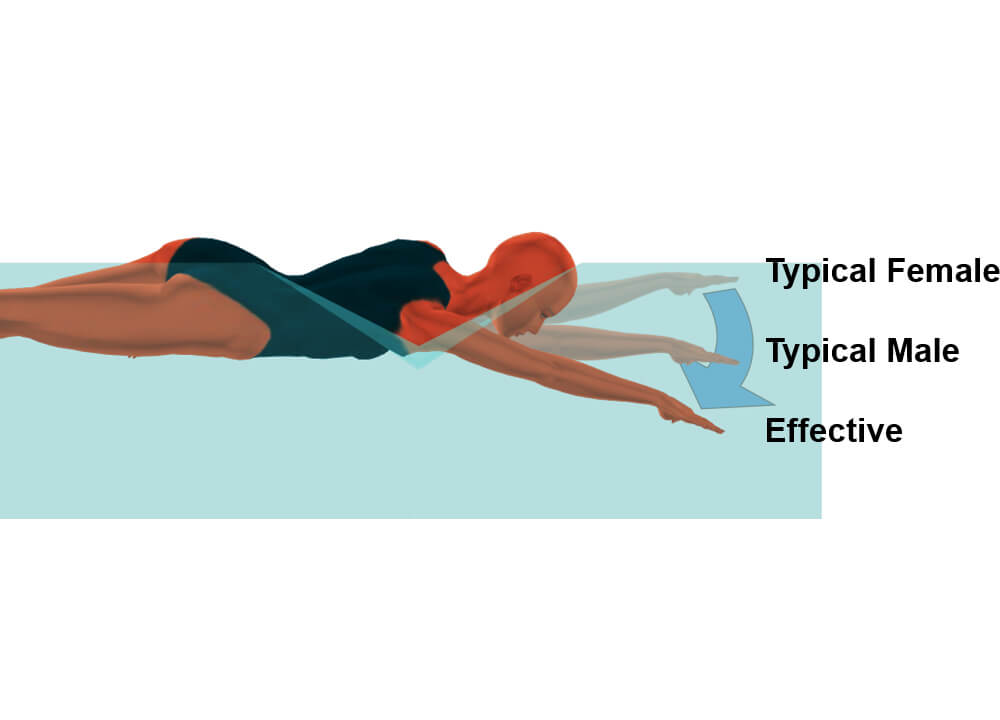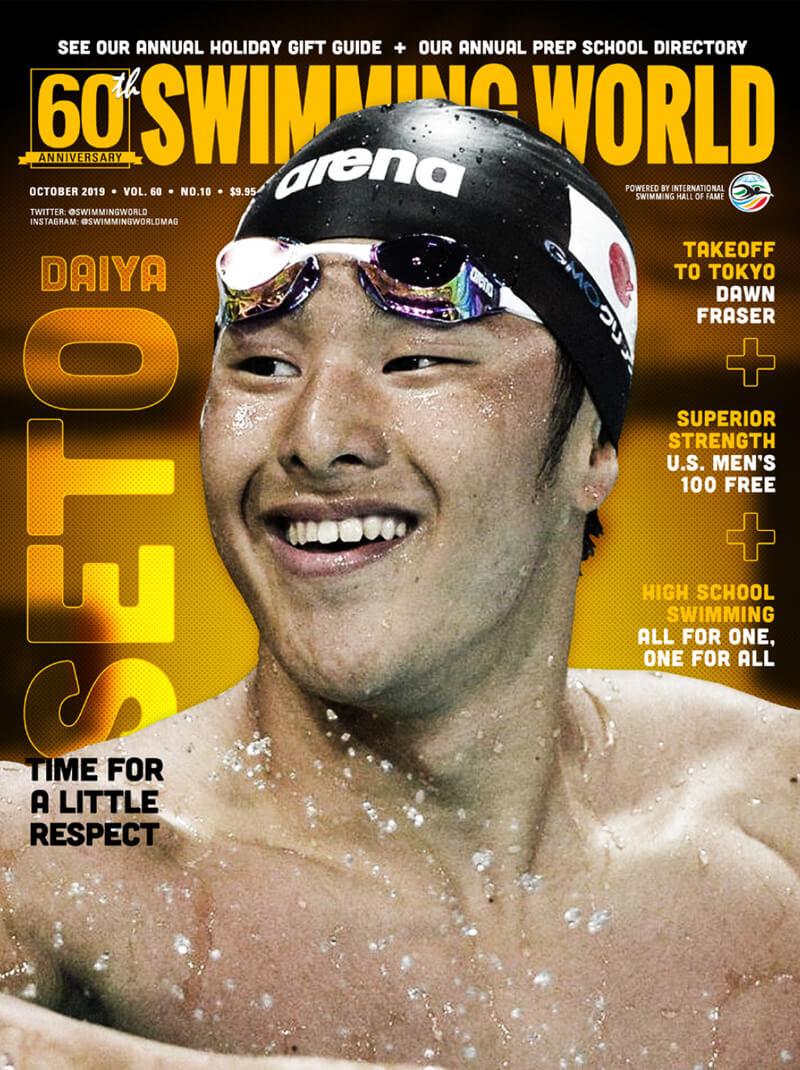Swimming World Presents “Swimming Technique Concepts: Shoulder Injury Prevention for the Freestyle Arm Entry”

Swimming Technique Concepts:
Shoulder Injury Prevention for the Freestyle Arm Entry
By Rod Havriluk
Studies show that there are a high percentage of swimmers suffering from shoulder pain (SW Aug. 2019). Studies also identify three major risk factors for shoulder pain/injury: overuse, muscular imbalance and harmful technique (SW Sept. 2019).
This article addresses a stroke phase that is almost universally harmful due to the severity and duration of shoulder stress: the freestyle arm entry.
An effective (and less stressful) arm entry provides more space for the soft tissue between the bones in the shoulder and upper arm. To achieve an effective arm entry, the hand must enter the water with a downward angle. At the completion of the entry, the hand is below the shoulder. Swimmer and coach can both evaluate this skill when the arm straightens by seeing the hand as the deepest part of the arm.
Unfortunately, this position is rarely seen in competitive swimmers. Consequently, specific strategies are necessary to improve this critical aspect of technique. On the arm recovery, a swimmer must elevate the elbow above the hand. If the elbow is the highest part of the arm on the recovery, it will be easier for a swimmer to enter the arm with a downward angle. In addition, the hand must enter close enough to the shoulder so that the arm straightens as it submerges.
While both the typical male and female arm entry stresses the shoulder, the typical female arm entry is more stressful. The severity of the female arm entry is confirmed by a study that compared the incidence of shoulder injuries in male and female university swimmers (Sallis, Jones, Sunshine, Smith & Simon, 2001). The study found that females suffered shoulder injuries about three times as often as males. The authors were unable to make any “gender-specific recommendations…for decreasing the incidence of injury to female athletes.”
However, it now seems that the arm entry—both the severity and duration—is likely responsible.
Dr. Rod Havriluk is a sports scientist and consultant who specializes in swimming technique instruction and analysis. His new book, “Swimming Without Pain,” is a comprehensive guide to preventing and rehabilitating shoulder injuries, available at www.swimmingtechnology.com. You can contact Rod through info@ swimmingtechnology.com. All scientific documentation relating to this article, including scientific principles, studies and research papers, can be provided upon demand.
To access the full article for tips and illustrations on proper freestyle arm entry,
check out the October issue of Swimming World, out now!
Get Swimming World Magazine and Swimming World Biweekly FREE When You
Become A Member of the International Swimming Hall of Fame
Want More? Subscribe With This Special 2-Year Offer!
New! 1-Year Digital Only Subscription for just $39.95 Order Now!
Non-Subscribers Can Download This Issue For Only $5.94
FEATURES
024 MYSTERIES OF OUR MUSEUM: A MYSTERIOUS MEDAL
by Bruce Wigo
A beautiful bronze medal commemorating a Japan-USA-Denmark International Swimming Meet led to the story of the best all-around woman swimmer from the early 1950s who also became one of the best Masters swimmers ever: Gail Peters Roper.
026 TAKEOFF TO TOKYO: DAWN OF GREATNESS
by John Lohn
When the 2020 Olympic Games open next July, there will be no round-number anniversary of what Australian Dawn Fraser accomplished 56 years earlier in 1964. Rather, it is the site of the Olympiad that resonates. As Tokyo prepares to host the world’s finest athletes, it also serves as the place where Fraser became the first swimmer ever to win Olympic gold in the same event at three consecutive Games—a feat that, even now, is wildly difficult to comprehend.
030 IT’S TIME FOR SOME RESPECT
by John Lohn
For someone to boast four World titles and seven individual medals from the World Championships, the instant assumption is that he stands out as one of the biggest names in the sport. Sure, Japan’s Daiya Seto is respected by his rivals and generally around the pool, but his exploits are greater than the recognition that has been given.
034 FASTER THAN EVER
by David Rieder
Heading into the 2020 Olympics, a young American sprint corps has turned the United States into heavy gold-medal favorites in both the 100 free and 400 free relay. However, the real contest will come at the U.S. Trials, where Olympic hopefuls must get through a cutthroat gauntlet of speed in order to earn their spots for Tokyo.
038 THE NEW “KIDS” ON THE BLOCK
by Craig Lord
This month marks the beginning of a new era in swimming with the unveiling of the International Swimming League, featuring a new and dynamic format of swimming that includes a global Pro-Team tour with some of the world’s greatest swimmers in action.
COACHING
010 LESSONS WITH THE LEGENDS: KAREN MOE HUMPHREYS
by Michael J. Stott
014 SWIMMING TECHNIQUE CONCEPTS: SHOULDER INJURY PREVENTION FOR THE FREESTYLE ARM ENTRY
by Rod Havriluk
Every team’s injury management plan should include strategies to address the freestyle arm entry and prevent shoulder injury. Major benefits also include increasing the index of coordination and, thereby, increasing swimming velocity.
016 A CASE FOR HIGH SCHOOL SWIMMING: ALL FOR ONE, ONE FOR ALL
by Michael J. Stott
The verdict is unanimous: high school swimming adds immeasurable value to the career and experience of a young athlete.
051 Q&A WITH COACH TERRY JONES
by Michael J. Stott
052 HOW THEY TRAIN KAITLYNN SIMS AND LILLIE NORDMANN
by Michael J. Stott
TRAINING
013 DRYSIDE TRAINING: BUILDING LEAN MUSCLE
by J.R. Rosania
JUNIOR SWIMMER
042 GOLDMINDS: BUILDING A TEAM OF GREAT SWIMMING PARENTS
by Wayne Goldsmith
When given the opportunity to understand the importance of their role and their influence, swimming parents can become the most powerful, positive force in their child’s life.
054 UP & COMERS: KEATON JONES
by Shoshanna Rutemiller
COLUMNS & SPECIAL SECTIONS
008 A VOICE FOR THE SPORT
009 BEYOND THE YARDS
018 DID YOU KNOW? MARTHA NORELIUS
019 HOLIDAY GIFT GUIDE
044 PREP SCHOOL DIRECTORY
055 GUTTERTALK
056 PARTING SHOT





Total immersion teaches this method.
Aya Ayman
Emilia Ström
Adam Schön oh I see
Homer Villalon
Lisel Johnson
Charles Henthorn
Coral Wilkens
Caden!
Rosalie Carrière
The importance of stroke technique is critical in the prevention of injuries for swimmers. Suggest that coaches and athletes use best practice methods of training accompanied by underwater video analysis monthly during the swimming season. Swimmers finally understand the coaches correction.